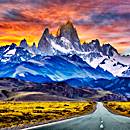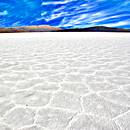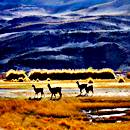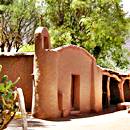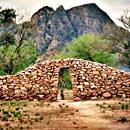Planning your Trip
Tips and advice on when to drive Ruta 40
Ruta 40 spans Argentina from the Strait of Magellan in the south to the Puna highlands in the north and it Can be visited all year round.
But it is preferable to visit some parts of the road during certain times of the year (to avoid snow or summer floods) and to keep away from the high season crowds and higher priced lodging.
Furthermore, each región that Ruta 40 goes through, in its path across Argentina has its own climatic peculiarities.
Spring on Rute 40
From to it is Spring in Argentina as it is located in the Southern Hemisphere.
What to expect from the weather during Spring?
Ruta 40 during Spring
Start planning now!
Low season along Ruta 40 except during long weekends. So hotels will be cheaper and also flights. However book with time in crowded destinations.
- North. Good dry weather, it hardly rains. This is the dry season until the end of November. Warm and pleasant during daytime and hotter as the season advances. Cool at night. Bright shining sun. Cold in the highlands of the Puna.
- Cuyo. Sunny, dry weather. Warm during the day, cool at night, hotter towards the end of spring. Not much rain until December. Clear skies, cooler in the high areas in the Andes.
- Patagonia. Days lengthen but spring arrives towards October, November. Cool during daytime and cold at night. Frost further south. Longer days and shorter nights as the season advances (due to the latitude). Rare snow fall in the high areas in the south. But do expect rain and overcast skies.
The Weather and Ruta 40: rain, ice, snow, low temperatures?
Best time of the year - weatherwise- for your trip
Ruta 40 runs north to south along the Andes and crosses three distinct areas, "North", "Cuyo" and "Patagonia", each has its own type of weather, altitude and geography:
- North: It spans the provinces of Jujuy, Salta, Tucumán and Catamarca.
- Cuyo: Comprises La Rioja, San Juan and Mendoza provices.
- Patagonia: From north to south includes Neuquén, Río Negro, Chubut and Santa Cruz.
According to the season you can expect the following extremes in weather:
- Summer in the North: it is the rainy season, but altitude mitigates the heat despite its proximity to the Equator (approx: 25° Lat S)
- Winter in Patagonia is the cold season : frost, snow, rain, cloudy overcast sky, bleak wind and very low temperatures.
- Spring and Autumn are the best seasons to travel the whole of Ruta 40, weather is not so extreme and is mostly sunny and warm.
Let's see the pros and cons of each season:
Autumn (Fall)
Good time of the year to drive Ruta 40: mild weather and few tourists (school starts in March and the first break is in July) so most families are back at home. However Easter and long weekends due to national holidays will fill up flights, car rentals, hotels and attractions.
Argentina's National Holidays
Some holidays fall on fixed dates while others move to the closest Monday. These are the dates, check out the National Holidays on the Argentine Govt.'s website.
January 1, Fixed.
February or March, Carnival, Movable, two days, Mon. & Tue, so it is a four day long weekend.
March 24, Fixed.
April 2, Fixed. Easter (Mar. or April) Good Friday and Easter Thursday, four day long weekend.
May 1 (labor day) and May 25 (Fixed)
June 17 (Movable) and June 20 (Fixed)
July 9, Independence Day (Fixed)
Winter holiday season begins in July, it is a 2 week period, but staggered over the month by the different provinces, so all of July is high season.
August, 17, Movable
September, no national holidays
October 12, Movable
November 18, Movable
December 8 and 25, Fixed. Christmas Eve and New Year's Eve are usually non-working days but they aren't official holidays.
High and Low Seasons: Different prices
Data on Tourist Inflow
More tourists... fuller hotels and higher prices...
The following charts (source INDEC, Argentine Statistics Office) show a marked seasonality in hotel room occupancy in the different regions and towns:
Bear in mind that each region also has other tourist attractions that are not located along Ruta 40 such as the hot springs at Termas de Río Hondo and Santiago del Estero (North), Merlo in Cuyo and Madryn, Las Grutas, Santa Rosa and Ushuaia (Patagonia).
This means that many attractions along Ruta 40 don't have such a marked seasonailty and attract tourists throughout the year (Bariloche, Mendoza, Malargüe, Cafayate are some examples).
Hotel occupancy rate in Cuyo Region
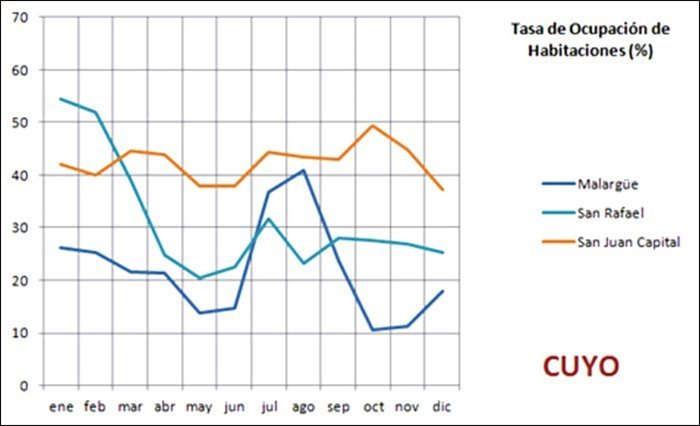
The chart shows how many rooms (as a percentage) are occupied in hotels in certain cities located in the Cuyo Region.
Malargüe (on Ruta 40) has a winter peak as skiers from nearby Leñas ski mountain lodge there. San Rafael (close to Ruta 40) is summer tourism -outdoor ⁄ nature activities. San Juan (on Ruta 40) is the provincial capital city and has a high and constant influx of tourists throughout the year.
Hotel occupancy in Patagonia
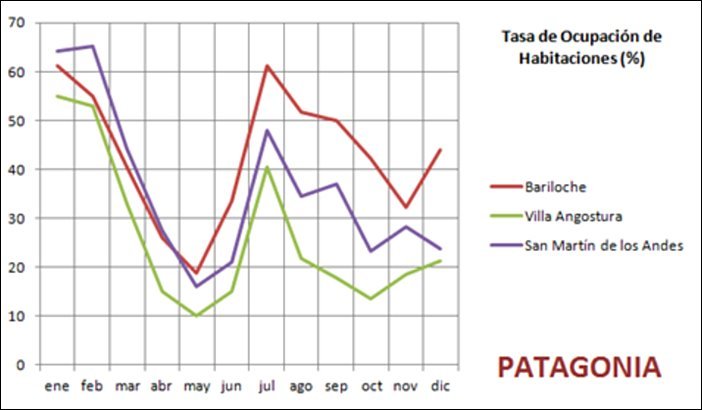
Northern Patagonia has two high seasons: summer and winter, the later due to ski and snow sports. Late Fall (April to June) and Spring are the "Low Season".
Hotel occupancy in the Northern Region
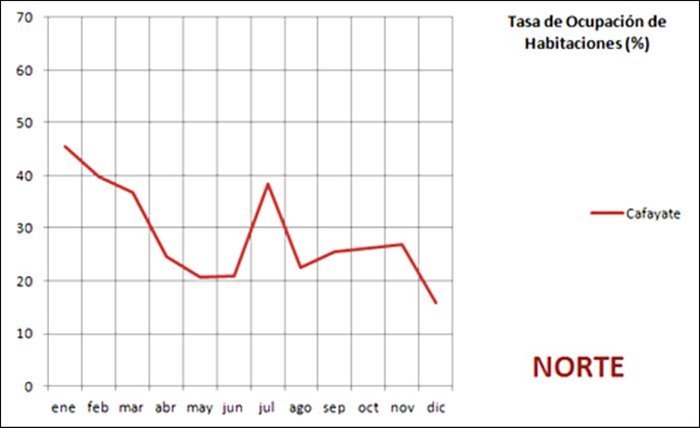
In Cafayate, Salta (on Ruta 40), the summer months of January, February and the July winter holiday period show peaks of tourist influx. The rest of the year is lower. Note that summer is the rainy season! .
How Many Tourists are we talking about?
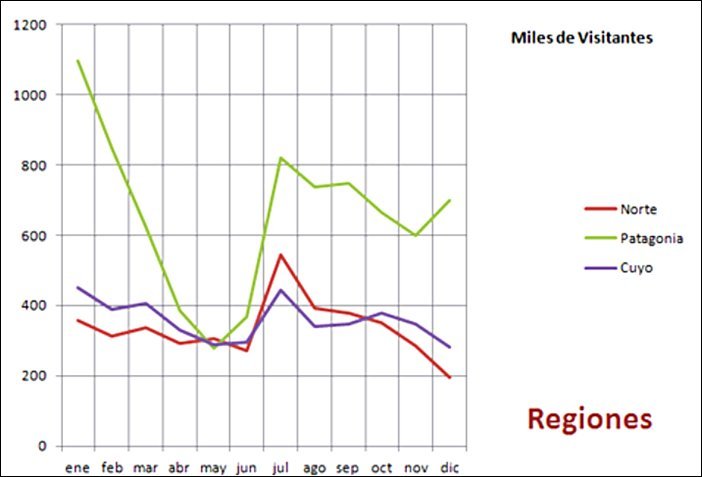
Patagonia is by far the most visited tourist destination along Ruta 40. It peaks in Summer and Winter. Cuyo and the North are fairly stable, with a peak during July winter holidays, and visitors taper off until January, when the summer vacation period begins.
High Season along Ruta 40
After Christmas and until the beginning of school year in March is the high season in Northern Patagonia and Cuyo. This impacts on room availability (hotels tend to fill up) and prices go up.
The same thing happens during the Winter Holidays in Northern Patagonia and Cuyo due to winter sports and skiing.
Low Season
Wintertime is low season in the southern parts of Patagonia (and also during August to December and March to June - families stay at home as their children go to school).
There are no ski resorts south of Esquel, in Chubut province.
In the North, especially in Salta and Jujuy provinces, it's the opposite: rainy season during summer means the "Tren de las Nubes" (Train to the Clouds) does not operate due to mudslides along its track, and the Salinas Grandes Salt flats are submerged with a layer of water.
But don't be put off, it does not rain every day, but when it does it pours. You can enjoy the Northern part of Ruta 40 during summer despite the occasional storm.
Summarizing the High and Low Seasons
Bear in mind that:
- Summer in the North is rainy, so visit it during the rest of the year avoid December to March.
- Winter brings snow and ice and cold weather to the Southern Part of Ruta 40, this means Patagonia and the south of Mendoza Province. Ski in the northern part of this region occupies hotels during June to August, but for the rest of the region it's Low Season.
- Summer (January to March), Winter holidays in July and long weekends mean crowds and full hotels plus higher lodging prices.
Rainy Season in the North
Rain & flash floods on Ruta 40
The Northwestern part of Argentina and Cuyo region north of the city of Mendoza experience a rainy season during Summer. This does not mean that it rains every day like in the Indian Monsoon, no, it just means that thunderstorms will downpour a lot of water during brief torrential events. These may happen once every 10 or 15 days.
This is an arid area and does not get much rainfall, only these summer storms.
Summer is balmy in the northern parts, which are located at altitudes above 1,500 m (4,500 ft) and this includes most of Ruta 40 in Salta, Jujuy, Tucumán and Catamarca.
Safety Warning
It may be a sunny day on Ruta 40 but it may be raining in the Andes or its foothills further west.
Torrential rain in the mountains, which are arid (only shrubs, no trees) means that the downpour quickly runs down the mountain slopes into gullies and ravines turning dry river beds into roaring rivers, dragging rocks, mud and branches. These mudslides cut the highways, flooding them and blocking them with debris.
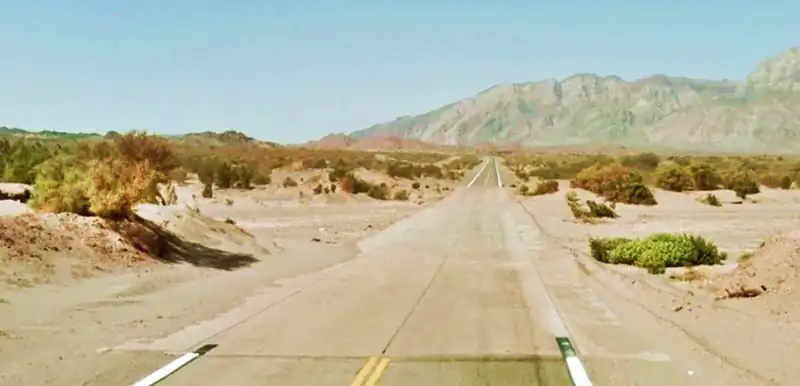
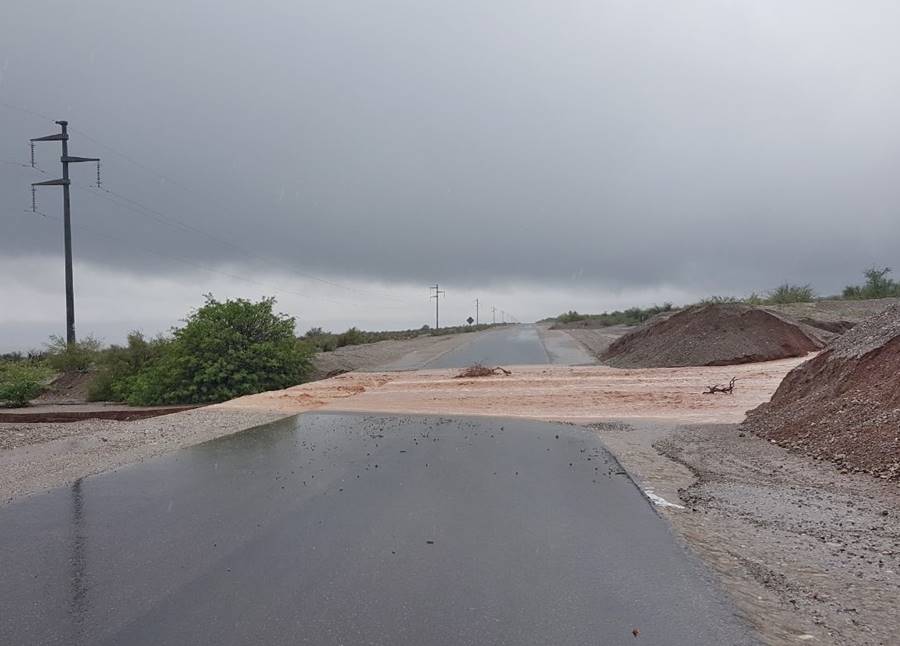
Drainage dips
Most of the area north of Mendoza city is criss crossed by dry stream beds with a West to East direction. To build a bridge across each of them would be enormously expensive (they carry water a few days each year, and when they do, the debris they bring would block the bridges or wash them away).
The solution to this problem is the use of concrete drainage dips or "hardened" fills with culvert, a cheaper approaach well suited for crossing dry streams which are prone to torrents.
Normal flows with little water is handled by a small culvert under the road and the occasional flash flood or debris avalanche will just wash across the road surface. It can be bulldozed away after the flash-flood.
It is called hardened because it has a concrete surface that can withstand the rushing water and the erosion of the debris.
They are called "Badén" in Spanish ("Bad-N" would be the English phonetic equivalent).
Snow and Ice in the Andes
Cuyo and Patagonia during Winter. Warning
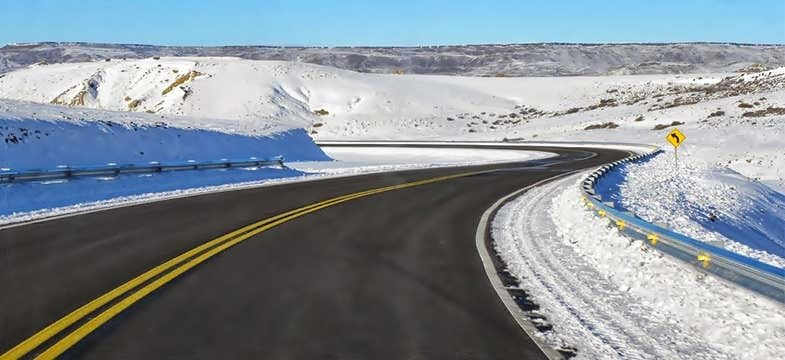
During winter you will possibly find snow in the Andean part of Ruta 40 along the Ruta de los Siete Lagos from Rinconada and the Collón Curá River in the north, all the way through San Martín de los Andes, Bariloche, El Bolsón and Epuyén. Snowfall is not that frequent, probably once or twice a month.
It is far more infrequent in the steppe but it can snow as shown in the image above.
From southern Mendoza province (Malargüe) to Chos Malal in Neuquén province you can experience snow and ice on the highway. Keep an eye open for ice in winter, use of salt is not very common so the road's surface can be quite slippery.
When to travel? That depends on the Season:
Weather along Ruta 40 during each season
This information summarizes the weather conditions throughout the year in each region.
Summer
- North. Rainy season, often torrential. May cut the road and. Cool summers due to the altitude.
- Cuyo. Hot summers, very hot during daytime, it is the rainy season too.
- Patagonia. Best time of the year to visit Patagonia, balmy weather, long daylight hours -longer as you move further south. Good weather, usually dry.
Winter
- North. Dry season, hardly no rain. Low temperature, cold at night. Dry air and altitude make it even colder. Sunny weather.
- Cuyo. Cool during daytime, cold at night, hardly no rain, clear skies. Zonda wind period, hot, dry and dusty.
- Patagonia. Cold during the day, colder at night (below freezing point). Rainiest time of the year (in the forested area -the steppe is arid, no rainfall). Possible snowfalls and frost - ice.
Spring & Autumn (Fall)
- North. Hardly any rain from March to November. Pleasant during the day, cold at night. Clear skies, sunny.
- Cuyo. Nice during daytime, cool at night, hardly any rain. Sunny, dry. (Zonda wind during Spring).
- Patagonia. Fresh, and nice during midday. Cold at night, may freeze. Gets colder as you go further south.
Useful LINKS
Read more about Ruta 40: Road sections, detailed mile-by-mile, attractions, tips, landmarks and more.
Location of Service Stations along Ruta 40.
Hotels & Accommodation along Ruta 40
Find your room in each province along the highway
Find Lodging
>> Hotels in City of Salta
Hotels in each province along Ruta 40
Must-See stops near Ruta 40
>> Find your room in Salta Province

